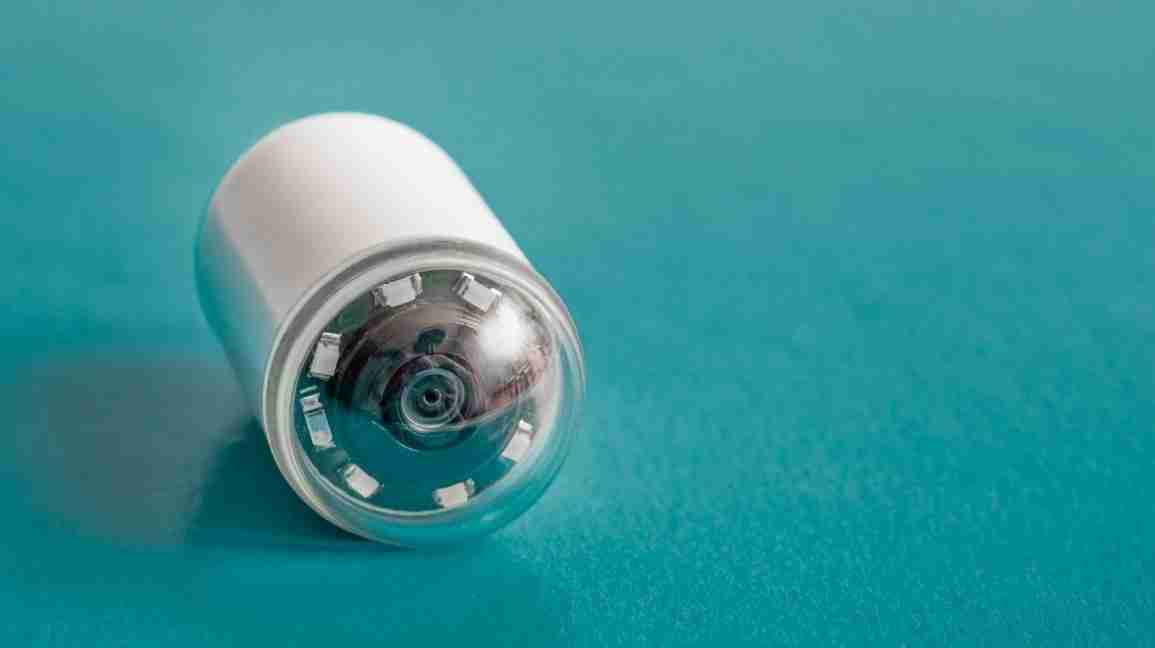An endoscopy is a procedure that uses imaging to evaluate the organs and tissues of your body, including your gastrointestinal (GI) tract.
Being able to visualize your GI tract can help your doctor to identify and diagnose a variety of different conditions.
There are several different endoscopy techniques. One of these is capsule endoscopy, which uses a small wireless camera to take pictures of your GI tract. This camera is housed within a pill-sized capsule that you swallow.
Continue reading to learn more about capsule endoscopy, when it’s used, and what the procedure is like.
The Food and Drug Administration (FDA) first approved capsule endoscopy for use in 2001. You may also see the procedure called wireless capsule endoscopy or video capsule endoscopy.
Capsule endoscopy uses a tiny wireless camera to capture pictures of your GI tract. The camera that’s used for the procedure is located in a small capsule that’s shaped like a pill.
When you swallow the capsule, the camera inside of it begins a journey through your GI tract. During this time, the camera takes thousands of pictures. These pictures are transmitted to a recording device that you wear around your waist.
Although it can be used to visualize many parts of the GI tract, capsule endoscopy is particularly useful for looking at the small intestine. This is because the small intestine is difficult to access using more conventional endoscopy techniques.
Let’s walk through what happens when you have a capsule endoscopy.
1. Procedure review
When you arrive for your appointment, your doctor will go over the procedure with you so you know what to expect.
2. Device setup
You’ll wear a recording device on your waist during the procedure. This device will store the pictures that the capsule takes as it moves through your GI tract.
You may be asked to briefly remove your shirt so that a series of electrode patches can be applied to the skin of your chest and abdomen. These patches will connect to the recording device. Not all devices use electrode patches.
3. Swallowing the capsule
You’ll be asked to swallow the capsule with a small amount of water. The capsule is about the size of a large multivitamin pill.
4. Daily activities
After you’ve swallowed the capsule, you can go about your daily activities for the next 8 hours.
Your doctor will give you guidelines to follow while the capsule is passing through your system. Generally, these include:
- waiting at least 2 hours before drinking clear liquids
- waiting at least 4 hours before having small snack
- avoiding any strenuous activities, particularly those that involve sudden, jarring movements or bending and stooping motions
A capsule endoscopy procedure is over when one of the following happens:
- 8 hours have passed
- the capsule passes out of your body during a bowel movement
Whichever happens first, you’ll then return to your doctor so that they can remove the electrodes and collect the recording device.
If you haven’t already passed the capsule, you’ll typically notice it in the toilet after a bowel movement in a matter of hours or days. Capsules are disposable and are safe to flush down the toilet.
Contact your doctor if it’s been several days and you haven’t passed the capsule. They may need to use imaging technology such as an X-ray to see if the capsule is still in your GI tract.
A capsule endoscopy has several useful applications, including:
- detecting the source of GI bleeding
- helping to diagnose or evaluate GI conditions like Crohn’s disease, celiac disease, and ulcerative colitis
- identifying polyps or tumors in the GI tract
- evaluating the esophagus for the presence of enlarged veins (varices) and Barrett’s esophagus
- evaluating abdominal pain with an unclear cause
Capsule endoscopy is currently limited to detection and diagnostic functions. It can’t yet be used for things like taking biopsies or delivering treatments. It’s hoped that these types of capsule technologies can be developed in the future.
The cost of capsule endoscopy can depend on many factors, including your location, your specific doctor or provider, and your insurance.
The cost of an individual capsule is around $500. However, this doesn’t include any additional costs associated with the procedure.
One
Not all insurance companies will cover capsule endoscopy. Because of this, it’s important to check with your insurance company to see if capsule endoscopy is covered before scheduling your procedure.
What about Medicare?
Medicare Part B will cover non-laboratory diagnostic tests when they’re medically necessary to make a diagnosis.
However, it’s important to remember that not all applications of capsule endoscopy may be considered medically necessary.
Medicare may cover capsule endoscopy for:
- GI bleeding
- Crohn’s disease
- celiac disease
- esophageal varices
However, it doesn’t cover it for other esophageal conditions or for colorectal cancer screening.
It also doesn’t cover patency capsules, which are used to be sure your intestinal tract is open enough for a capsule endoscopy to pass through.
Medicare Part C (Medicare Advantage) plans are offered by private insurance companies. Because of this, they may have slightly different guidelines for coverage of capsule endoscopy.
Regardless of the type of Medicare coverage you have, it’s important to check if capsule endoscopy is covered prior to your procedure. You can do this by contacting Medicare directly or by contacting your Part C plan’s provider.
Overall, capsule endoscopy is a safe procedure, although there’s a very small risk of the capsule getting stuck in your GI tract.
This is more likely to happen in individuals who have a significant narrowing in the GI tract due to things like:
- inflammation from an inflammatory bowel disease (IBD), such as Crohn’s disease or ulcerative colitis (UC)
- the presence of large polyp or tumor
- a previous surgery or injury that’s caused part of the GI tract to be narrower
Many times, a capsule that’s become stuck will eventually pass on its own. However, sometimes it may cause symptoms like:
In these cases, it may need to be surgically removed.
If your doctor believes capsule retention is a potential risk, they may use the following prior to a capsule endoscopy:
- Patency capsule. This is a capsule that you swallow to help evaluate your risk for capsule retention. If the patency capsule can effectively move through your GI tract, you’ll notice that you pass it during a bowel movement. If it becomes stuck, it’ll dissolve and not be passed.
- Imaging. Using imaging technology like a CT scan or MRI scan can check for narrowing in the GI tract.
- Corticosteroids. If your GI tract is affected by inflammation, you may be given a course of corticosteroids prior to a capsule endoscopy. These are drugs that reduce inflammation.
Capsule endoscopy may not be recommended if you have any of the following:
- Swallowing disorders. These disorders may lead to difficulty swallowing the capsule. There’s also the risk that you could inhale it.
- Pregnancy. There are limited studies on the safety of capsule endoscopy in pregnant women, so it’s not recommended at this time.
- Implanted devices like pacemakers or defibrillators. Pacemakers, defibrillators, and other devices may cause interference between the capsule and the recording device. However, newer studies show this may no longer be an issue.
How to prepare for a capsule endoscopyThere are several things that you’ll likely have to do in preparation for a capsule endoscopy:
- Maintain a clear liquid diet the day before your procedure.
- Take a laxative solution to help clear your GI tract, which can improve camera visibility.
- Don’t eat or drink in the 10 to 12 hours prior to your procedure.
- Don’t take certain medications that may interfere with the camera.
This is just a general outline of the preparatory steps before capsule endoscopy. Your doctor will give you more specific instructions prior to your procedure. Be sure to follow them carefully so that your procedure can occur as scheduled.
After your procedure, your doctor will collect the recording device that’s attached to your waist. They’ll then transfer the images from that device to a computer.
Specialized computer software will produce a video by stringing together the images that the camera has collected. Your doctor will then watch this video to evaluate the capsule’s trip through your GI tract and look for any abnormalities.
When your doctor has thoroughly reviewed the video, they’ll contact you to go over the results. You’ll typically hear from them about 2 to 3 weeks after your procedure.
Capsule endoscopy uses a small camera inside a pill-shaped capsule to take pictures of your GI tract. It can be used to detect and diagnose conditions like GI bleeding, Crohn’s disease, and celiac disease.
The procedure lasts for 8 hours or until you pass the capsule during a bowel movement. When it’s over, your doctor will collect the recording device and compile the images into a video that they’ll then review.
Overall, capsule endoscopy is a safe procedure with minimal risk. However, there’s a very small risk of the capsule getting stuck in your GI tract. Your doctor will work with you prior to your procedure in order to avoid this.
The cost of capsule endoscopy depends on many factors, such as insurance and your location. Always be sure to check with your insurance provider to verify that capsule endoscopy is covered before scheduling your procedure.

